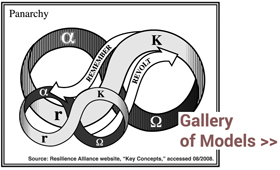“The essential characteristic of systems theory,” described theoretical biologist Robert Rosen, is that “there is a sense in which we can learn about S by studying S’.”
This pithy statement comes from Rosen’s “Old Trends and New Trends in General Systems Research,” the Ludwig von Bertalanffy Memorial Lecture at the 1979 meeting of the Society for General Systems Research. Rosen was born on today’s date in 1934.
Here’s the full excerpt:
[T]here is a sense in which we can learn something about a particular system S, such as a developing organism, by studying some other system S’, perhaps completely different from S in purely reductionistic or physical sense, but nonetheless manifesting the same behavior.
To me this last proposition articulates the essential characteristic of systems theory, which distinguishes it from everything that has gone before. Hitherto, the reductionistic-empirical approach to systems mandated that any given system of interest be analyzed into ultimate particulate units; understanding any behavior of the system meant resolving that behavior into the properties of these particulate units and the forces acting on them. On the other hand, von Bertalanffy stressed that in the organic realm, many important classes of behaviors are shared by systems of the utmost physical diversity.
This fact has, in turn, two utterly revolutionary implications: first, that if such behaviors are to be analyzed, the appropriate analytic units cannot be the particles of the physicist, and hence, that the reductionist analytic paradigm is not the only one of the large family of analytic paradigms, each of which captures a distinct aspect of physical reality. The second implication, which arises from the first, is this: if two systems S and S’ which are physically different (i.e. are constructed of different kinds of particles) nevertheless behave similarly, then there is a sense in which we can learn about S by studying S’. That is, physically disparate systems can nevertheless be models, or analogs, of each other.
These days, familiar examples of learning about S through S’ include:
- Resilience science, in which studies, initially in ecological systems, of multiple stable states and critical transitions have informed understandings of persistence, adaptation, and transformation in systems of a more social character.
- Scaling laws that describe similar rates of growth among animals (metabolism per-unit of body mass) or cities (per-capita rates of crime, innovation, and so on), as described by Geoffrey West and colleagues, e.g., “Growth, innovation, scaling, and the pace of life in cities.”

